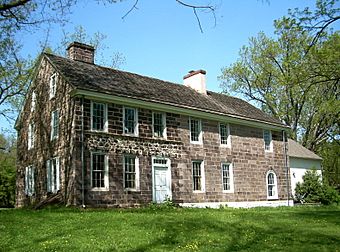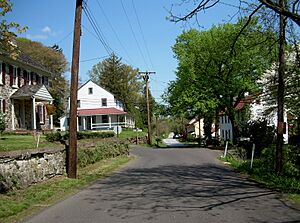Coventryville Historic District facts for kids
Quick facts for kids |
|
|
Coventryville Historic District
|
|

Coventry Hall, built c. 1730.
|
|
| Nearest city | Pottstown, Pennsylvania |
|---|---|
| Built | 1731 |
| Architectural style | Georgian, Federal |
| NRHP reference No. | 78002378 |
| Added to NRHP | January 31, 1978 |
The Coventryville Historic District is a special historic district in Chester County, Pennsylvania, United States. This old village played a very important role in America's early metal industry.
Contents
How Did Coventryville Begin?
Coventryville started with an iron forge. A forge is a special workshop where metal is heated and shaped. This one was built in 1717 by Samuel Nutt, an Englishman.
Samuel Nutt was an early American industrialist. He was also a member of Pennsylvania's government for a few years. He named the forge "Coventry" after his hometown in England. It was the first forge in all of Chester County.
The forge was built where two parts of French Creek meet. This spot was chosen because it was close to rich iron deposits. Iron ore is the rock from which iron is taken.
Important Iron Industry Pioneers
In 1723, Samuel Nutt teamed up with two other important people. One was Mordecai Lincoln, who was the great-great-grandfather of Abraham Lincoln. The other was William Branson, another iron pioneer.
Together, they made their business bigger. They added two furnaces, called Warwick and Reading. A furnace is a large oven used to melt metal. At Reading Furnace, William Branson experimented. He was able to make some of the very first steel in America that same year!
Coventryville's Owners and Benjamin Franklin
After Samuel Nutt passed away in 1737, Coventry went to his nephew, Samuel Nutt Jr. When Samuel Nutt Jr. died, his wife, Rebecca Savage, inherited the site.
Rebecca later married Robert Grace. Coventry and Warwick then became known as "Rebecca Nutt and Company." Robert Grace was a close friend of Benjamin Franklin. Because of this friendship, there's a popular story. It says that the famous Franklin Stove was first tested at Grace's home, which was called Coventry Hall.
In 1757, Coventry and Warwick were passed to Thomas Potts. He was Rebecca's son-in-law and the father of John Potts, who founded the nearby town of Pottstown.
Coventryville During the American Revolution
By the time of the American Revolution, Coventry was owned by Thomas Potts's brother, Samuel, and Thomas Rutter. Under their ownership, Coventry and Warwick played a vital role. They supplied important supplies, like ammunition, to the Continental Army. This was the army fighting for America's independence.
Why Did the Ironworks Close?
In the early 1800s, the Coventry forge was made bigger and updated. Many of the buildings you see in the village today were built around this time.
However, big changes were happening in the metal industry. People started using anthracite coal instead of charcoal for fuel. Also, new ways to make iron and steel were developed. Smaller operations like Coventry and nearby Hopewell were far from coal mines. They also weren't near major train lines.
Because of these changes, the ironworks at Coventry began to decline. There were short times when production went up, like during the American Civil War. But Coventry Forge completely stopped working in 1871.
Coventryville Today
Today, the village of Coventryville still has many old buildings. These buildings date from the early 1700s to the mid-1800s. You can see homes where workers lived, an old Inn, and the ironmaster's house (Coventry Hall). There's also a Methodist church from the mid-1800s.
In 1959 and 1960, Route 23 was moved to the south of the village. This change destroyed a part of the old forge site. However, the Coventryville Historic District is still a well-preserved collection of original buildings from the 18th and 19th centuries. The community was officially added to the National Register of Historic Places in 1978.




